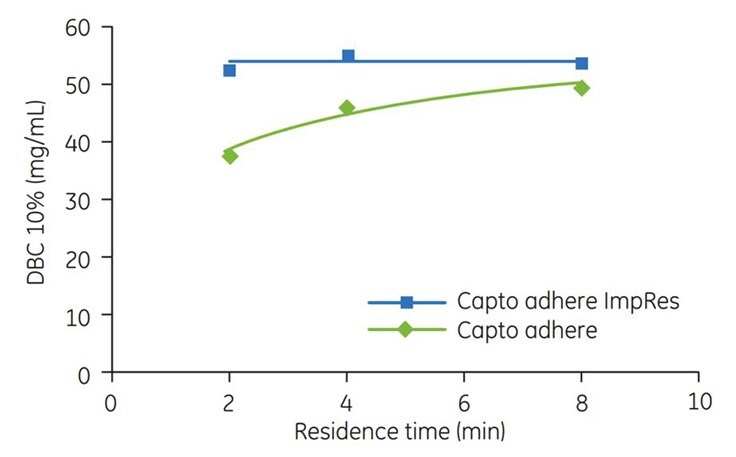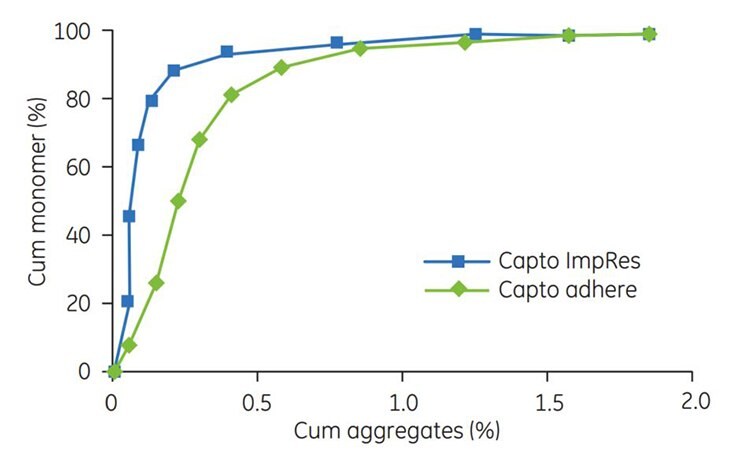Capto Adhere ImpRes
Capto adhere ImpRes is a cost-effective and flexible chromatography medium designed for high-resolution polishing of MAbs. Capto adhere ImpRes is a multimodal anion exchange medium with the same ligand as used with Capto adhere (Figure 3.2). It displays high resolution due to its small bead size (40 μM compared with 75 μM for Capto adhere). The high resolution obtained with Capto adhere ImpRes enables reduced buffer consumption and improved product yield when compared with Capto adhere. Impurities/contaminants such as DNA, HCP, leached protein A, aggregates, endotoxin, and viruses are efficiently separated from the target Mab in bind/elute or flowthrough modes in either two- or three-step purification schemes. The influences of different salt types and additives are the same as for Capto adhere, as discussed above. The medium can also be used for purification of other recombinant proteins and biomolecules. For a MAb application example, see the Capto adhere ImpRes Example 1 in Chapter 4 (Polishing of MAbs using Capto adhere ImpRes in bind/elute mode).
Fast mass transfer
The small particle size of Capto adhere ImpRes generally results in a higher dynamic binding capacity (DBC) and also less sensitivity to changes in residence time than is the case with Capto adhere. These effects are exemplified in Figure 3.6.

Figure 3.6.DBC of a MAb vs residence time. DBC at 10% breakthrough measured in 90 mM sodium phosphate, pH 7.75.
High resolution and small pool volumes
Another advantage of Capto adhere ImpRes, associated with the smaller particle size, is an improved resolution that gives a better clearance of impurities. An example of this is shown in Figure 3.7, where aggregate removal and yield of Capto adhere ImpRes and Capto adhere are compared in bind/elute mode. The result shows that while a good separation was achieved between monomer and aggregates using Capto adhere, separation was further improved using Capto adhere ImpRes.

Figure 3.7.Cumulated aggregates vs cumulated MAb monomer yield after linear gradient elution using Capto adhere ImpRes and Capto adhere.
The high resolution of Capto adhere ImpRes is also maintained by using step elution instead of linear gradient elution, as shown in Table 3.2. The sample load was 70% of DBC 10%. Fractions were pooled and analyzed for yield, aggregate, HCP concentration, and pool volume. Despite a 20% higher load, step elution from Capto adhere ImpRes resulted in higher yield and better aggregate clearance compared with Capto adhere (Table 3.2). HCP levels were below the detection limit for ELISA for both media. Pool volume was also significantly smaller with Capto adhere ImpRes compared with Capto adhere.
1 Measured with general ELISA from Cygnus Technologies.
Capto adhere ImpRes and Capto adhere were compared in a MAb flowthrough step (Table 3.3). Using a residence time of 4 min, the aggregate and protein A clearance were equivalent for both media, while Capto adhere ImpRes gave higher yield and improved HCP clearance.
At 2 min residence time, Capto adhere ImpRes showed equivalent yield and protein A and HCP clearance, while a slight increase in aggregate level was observed.
* Refer to Figure 3.1 (Multimodal chromatography media) for bed height limitations at short residence times.
Regeneration
Due to its multimodal properties, regeneration of Capto adhere generally requires an acidic strip prior to CIP (Appendix 2, Maintenance of media and storage conditions)
Materials
To continue reading please sign in or create an account.
Don't Have An Account?